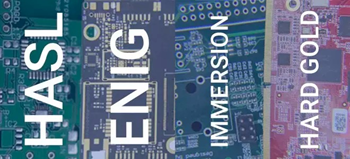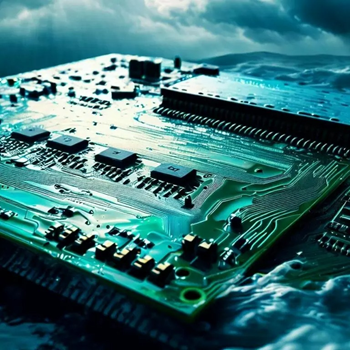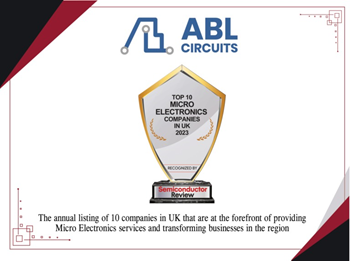PCB Surface Finishes: An In-Depth Guide
The PCB surface finish is one of the most important parts of the PCB manufacturing process. Choosing the right surface finish will ensure optimum performance, protection, durability and compliance. Many types of surface finish can be used on a PCB, with each suited to different environments, budgets and compatibilities. In this post, we’re going to take an in-depth look at PCB surface finishes, including the different types and how to choose the right PCB surface finish for your board. Understanding PCB surface finishes First, if you’re not familiar with PCB surface finishes, we’ll briefly explain what they are, what they do and why they’re so important when it comes to PCB manufacturing. Surface finishes are the thin layer of coating that’s applied to copper surfaces on a printed circuit board (PCB). Without it, the copper would be exposed to the elements, which would quickly lead to oxidation and corrosion. And this, of course, means the PCB would soon develop catastrophic faults. Basically, PCB surface finish is a protective coating that improves the functionality and reliability of a PCB while ensuring its longevity. Surface finishes also facilitate solderability by providing a reliable solder joint. Each surface finish has slightly different characteristics which means one might be more suitable than another for certain requirements. Most allow for the assembly of fine-pitch components while ensuring solder mask misalignment and tombstoning are avoided. The role of PCB surface finishes in enhancing PCB performance Another important role that PCB surface finishes play is in enhancing the overall performance of a PCB by: • Reducing impedance variations • Enhancing integrity • Reducing signal loss • Increasing longevity • Increasing compatibility • Enhancing conductivity • Improving durability Types of PCB surface finishes As mentioned at the start of this article, there are many types of PCB surface finishes, with each having a slightly different function depending on various factors. These are: • Hot Air Solder Level (HASL) • Lead-Free HASL • Organic Solderability Preservative (OSP) • Immersion Silver (Au) • Immersion Tin (Sn) • Electroless Nickel Immersion Gold (ENIG) • Electroless Nickel Electroless Palladium Immersion Gold (ENEPIG) • Electrolytic Wire Bondable Gold • Electrolytic Hard Gold Below, we’ll go into detail about each one, including when they might be used and the advantages and disadvantages of each. Hot Air Solder Level (HASL) Hot Air Solder Level (HASL) is the most commonly used type of PCB surface finish and is applied after the solder mask. It’s around a 60/40 mix of tin and lead and is used on boards with thru-hole tech. It doesn’t result in a particularly flat finish, which means it isn’t suitable for Surface Mount Devices (SMD). Advantages of HASL • Affordable • Commonly used • Industry-standard • Simple process • Strong durability Disadvantages of HASL • Isn’t particularly uniform • The heat can cause imperfections • Contains lead Lead-Free HASL Similar to HASL, however lead-free HASL contains, as the name suggests, no lead. Instead, it’s a mix of tin and copper but mostly relies on tin, with less than 1% being copper. Advantages of lead-free HASL • Affordable • Isn’t particularly uniform • Excellent durability • Strong solderability Disadvantages of lead-free HASL • Difficult to use for smaller circuit boards • Requires higher temperatures Organic Solderability Preservative (OSP) Organic Solderability Preservative (OSP) is an organic, water-based compound. It offers a flat finish and has the advantage of being lead-free. It can only be applied after every process has been completed, which includes final tests and inspection. Because its organic boards should be assembled in a relatively short time frame. Advantages of Organic Solderability Preservative (OSP) • Affordable • Uniform • Simple • Lead-free Disadvantages of Organic Solderability Preservative (OSP) • Short shelf life • Unable to measure the thickness • Cannot be used for plated through holes Immersion Silver (Au) Because silver is such a conductive metal and produces a flat surface it’s ideal for surface-mount device (SMD) assembly. It offers great solderability, however, it has a shorter shelf life than other finishes and the board should be soldered almost immediately after it’s removed from storage. It’s applied after etching. Advantages of Immersion Silver (Au) • Affordable • Even application • A more environmentally friendly option Disadvantages of Immersion Silver (Au) • Very short shelf life • Offers little flexibility • Is easily tarnished • Isn’t as durable as other finishes Immersion Tin (Sn) Immersion Tin is very thin and flat, and is bright white in appearance, which is why it’s also known as White Tin. It’s applied in an electroless chemical bath and is less than 1.0 microns thick. It’s great for SMD assembly. Advantages of Immersion Tin (Sn) • Flat finish • Shelf life of a year • Great for press fit pin insertion Disadvantages of Immersion Tin (Sn) • Is easily damaged • Can lead to tin whiskers • Exposed tin is susceptible to corrosion on final assembly Electroless Nickel Immersion Gold (ENIG) Electroless Nickel Immersion Gold (ENIG) is a layer of gold on top of an initial layer of nickel that ensures the gold doesn’t migrate into the copper. During the soldering process, the gold will be absorbed which means you solder directly to the nickel. It’s a strong conductor and provides an even surface. Advantages of Electroless Nickel Immersion Gold (ENIG) • Flat surface • Great for plated through holes • Great shelf life • Strong conductor Disadvantages of Nickel Immersion gold (ENIG) • A more expensive option • Complex • Signal loss Electroless Nickel Electroless Palladium Immersion Gold (ENEPIG) Electroless Nickel Electroless Palladium Immersion Gold (ENEPIG) is quite the mouthful but has a range of advantages that mean it’s a great option for mixed assembly technologies thanks to excellent solderability, corrosion resistance and wire bondability. As the name suggests, it has three layers: electroless nickel, electroless palladium and immersion gold. As a result, it is more expensive but it is exceptionally reliable. Advantages of Electroless Nickel Electroless Palladium Immersion Gold (ENEPIG) • Incredibly flat surface • Multi-cycle assembly • At least a years shelf life • Excellent solderability • Reliable Disadvantages of Electroless Nickel Electroless Palladium Immersion Gold (ENEPIG) • Fairly expensive • Has some processing limitations Electrolytic Wire Bondable Gold Also known as soft gold, Electrolytic Wire Bondable Gold can be bonded to more easily than hard gold, but the gold doesn’t migrate which allows for stronger joints and better connections. It’s usually applied before solder mask and is applied using an electrical current. Because it’s almost 100% pure 24-carat gold, it can be rather expensive. Discuss the process, advantages, and disadvantages of Electrolytic Wire Bondable Gold. Advantages of Electrolytic Wire Bondable Gold • Has a long shelf life • Allows for strong joints • Ensures strong connections Disadvantages of Electrolytic Wire Bondable Gold • Can be expensive Electrolytic Hard Gold Electrolytic Hard Gold is, as the name suggests, harder than Electrolytic Wire Bondable Gold. Its hardness allows it to withstand multiple uses, but an active flux should always be used. It’s usually 98% pure 24-carat gold. Advantages of Hard Gold • Hard (as the name suggests) and durable • Long shelf life Disadvantages of Hard Gold • Expensive • Time-consuming to work with • Demarcation • Requires bus bars Choosing the right PCB surface finish When it comes to selecting the right surface finish for your board, several factors should be taken into consideration. • Environment – The environment the PCB will operate in is one of the most important factors. Temperature, humidity and whether or not it will experience chemical or gas exposure must be considered. For example, if the PCB will operate in a harsh environment you should use a surface finish that provides greater durability and offers more corrosion resistance, such as hard gold or Electroless Nickel Immersion Gold (ENIG). • Application requirements – The application of the PCB is also incredibly important. For example, fine-pitch components will require a flat, even surface. For this, you might consider Immersion Silver or Immersion Tin. • Cost – Cost is always a deciding factor. If you have a larger budget, you could afford the reliability that comes with Hard Gold. However, depending on your requirements Immersion Silver could be a viable option if you have a stricter budget. • Compliance requirements – The finish you opt for must be compliant with the relevant regulatory and environmental requirements. For example, there may be times when Hot Air Solder Level should not be used due to it containing lead. This is also something to be mindful of when manufacturing for clients in different regions. • Longevity – While the very process of applying a surface finish adds longevity to a PCB, some finishes are more reliable than others. Plus, general wear and tear, plus thermal cycling and environmental factors will play a part. PCB surface finishes at ABL Circuits Here at ABL Circuits, we prioritise quality and customer satisfaction over everything. That means we listen to you and your requirements to ensure your needs are always met. To ensure constant quality and that our PCBs have maximum longevity, we focus on Electroless Nickel Immersion Gold (ENIG) which provides a quality and durable finish. Because we don’t use silver, the gold finish tends to last much longer and is a much stronger conductor. For us, ENIG strikes the right balance between affordability, functionality and quality. In certain circumstances, we also use Hot Air Solder Level (HASL), such as when we’re working with through-hole components. Get started with a no-obligation quick quote today! The surface finish of any PCB is one of the most important parts of the manufacturing process. Without it, PCBs simply wouldn’t function properly and would corrode almost instantly. At ABL Circuits, we pride ourselves on being one of the UK’s most efficient PCB manufacturers. Get a free trial today and enhance your product with ABL Circuits.Visit the ABL Circuits Ltd website for more information on PCB Surface Finishes: An In-Depth Guide




